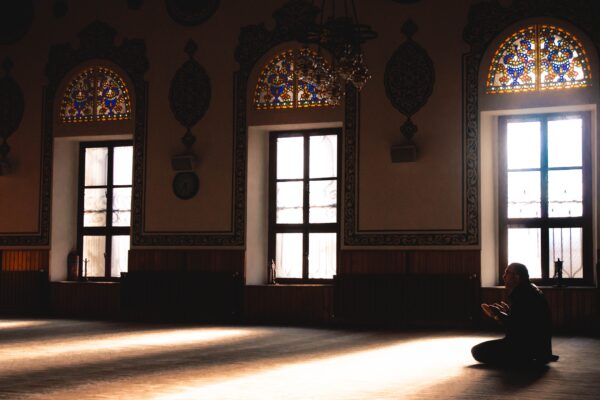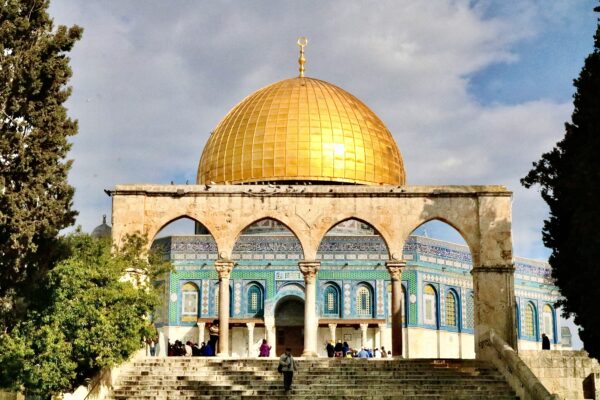Regarding the Quranic verse: “And the heaven He has raised high, and has set up a Balance” (Quran 55:7), Allah (SWT) created the earth as a sphere with the sun heating the equatorial regions more than the polar regions. As a consequence, some regions of the planet are abundant in energy and other regions are deficient in energy. This divine commandment is commonly known by physicists as the 2nd law of thermodynamics.
Regarding the Quranic verse: “And the heaven He has raised high, and has set up a Balance” (Quran 55:7), Allah (SWT) created the earth as a sphere with the sun heating the equatorial regions more than the polar regions. As a consequence, some regions of the planet are abundant in energy and other regions are deficient in energy. This divine commandment is commonly known by physicists as the 2nd law of thermodynamics.
The conception of knowledge (Al-Ilm) in Islam is the Guiding Light (Huda) separating right from wrong (Al furqan). Therefore, in the same way the sun brings light to our eyes to see the world around us, Al-Ilm is the source of guidance to see the Truth.
The sacred position of knowledge in Islam is also proven by the fact that the word “science” and its derivations appear 779 times (averaging 7 times a chapter) in the Quran [1]. This is the second position after the word “Allah”. The Prophet (PBUH) was then selected to educate his followers and all humanity in order to erase their ignorance with knowledge. In order to highlight the importance of knowledge to humanity, the first Quranic verse sent to Prophet Muhammad (PBUH) by Allah (SWT) through Angel Gabriel started was “Read!” (Quran; 96:1) [1].
To understand the universe, scientists around the planet have tried to find some universal laws such as statements that describe or predict a range of natural phenomena in the universe. In this perspective, Allah (SWT) exhorts Muslims to observe and study the universe in order to find some marks of His signs. For that reason, many verses of the Quran ask Muslims to study nature, and this has been interpreted to mean the encouragement for scientific inquiry.
The Divine Science
Regarding the Quranic verse: “And the heaven He has raised high, and has set up a Balance” (Quran 55:7) [1], Allah (SWT) created the earth as a sphere with the sun heating the equatorial regions more than the polar regions. As a consequence, some regions of the planet are abundant in energy and other regions are deficient in energy [2]. This uneven distribution of solar radiation is responsible for the imbalance of energy around the planet.
According to this first Quranic verse, one can understand that Allah (SWT) has imposed some divine laws in order to set up a balance on earth. Because He is “The Impartial Judge” and “The Wise One” (SWT), this equilibrium is established by driving matter and energy to move from places on earth that have “concentrated” energy to regions on earth with “diluted” energy. This divine commandment is commonly known by physicists as the 2nd law of thermodynamics.
Indeed, this law states that heat can be transferred only from higher temperatures to lower temperatures, fluids can flow only from higher pressures to lower pressures, and that rain falls from the sky to earth. Since this law is related to flows in nature, this aspect of the 2nd law of thermodynamics is defined in this book as the 1st universal law of dynamic systems and can simply be written as:
![]()
First Divine Law of Charity
Considering energy as a richness and based on the Quranic verse “The seven heavens and the earth and all that is therein, glorify Him and there is not a thing but glorifies His Praise. But you understand not their glorification” (Quran; 17.44) [1], flows in the dynamic earth are therefore moving from a region rich (concentrated) in energy to a region poor (diluted) in energy.
My spiritual understanding of this physical phenomenon tells me that “The Just One” (SWT) established a balance in the universe by imposing on places on earth rich in energy provided by Him using the sun, to share part of their richness with the regions of earth poor in energy. Consequently, every single space rich in energy is glorifying Allah (SWT) by sharing part of its richness (energy) in order to respect the balance imposed by Allah (SWT) on earth.
From this spiritual interpretation of movements in nature, the 1st universal law of dynamic systems is defined in this paper as the 1st divine law of charity imposed by Allah (SWT) on the universe. As a result, equation (1) of dynamic systems becomes:
![]()
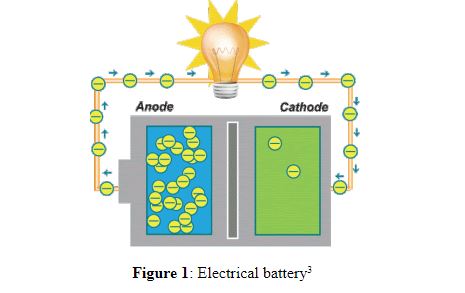
As shown in Figure 1, a typical example of the 1st divine law of charity is that the anode (rich in electrons) of an electrical battery is urged to give some electrons to the cathode (poor in electrons). In this case, the scientific explanation of the 1st divine law of charity is called the Electromotive force (Emf), which is defined as the characteristic of any “energy source” capable of moving electrons inside an electrical circuit.
Second Divine Law of Charity
Secondly, from this Quranic verse: “And there is not a thing but that with Us are its depositories, and We do not send it down except according to a known measure” (Quran, 15:21) [1], everything transported in the universe has a fixed measure determined by “The All Authoritative One” (SWT). Therefore, natural flows obey Allah (SWT) by always moving from places of “rich energy” to places of “poorer in energy”, and additionally their quantity and timing are also predestined by a second divine commandment.
For example, according to the Quranic verse “And we sent down from the sky water (rain) in (due) measure” (Quran; 23:18) [1], the amount of rain or snow (water) that falls and its timings are predetermined by Allah (SWT).
In any dynamic system, the flow could be described as being mathematically proportional to its driving force and inversely proportional to its resistance – and the following qualitative general equation of dynamic systems was introduced:
![]()
In order to relate this general equation to the Quranic verse (15:21), the difference in energy between a region on earth having high energy (EHigh) and a region having low energy (Elow) is considered as the “driving force” of any natural process and, the fluid or solid between these two regions presents a resistance “R” to the flow under consideration. Based on the equation above, the predetermined flow of matter or energy transported could be qualitatively represented by:
![]()
This equation is defined in this paper as the qualitative approach of the 2nd universal law of dynamic systems that deals with the amount of matter or energy to be transferred. In concordance with the 1st divine law of charity, looking spiritually in the direction of the arrow in Figure 2, it could be perceived that heat (Q) is flowing from the hot part of the material “rich” in thermal energy (T2 › T1) to the cold part of the metal “poor” in thermal energy.
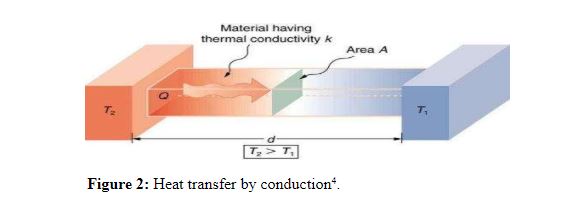
Furthermore, as shown in Figure 2, the “gradient of richness” of heat (Q) is the difference in temperature (T2 –T1) between the two parts of the material. If k is the thermal conductivity of the material, (1/k) is therefore the resistance to the heat flow (Q). Based on the 2nd divine law of dynamic systems, the amount of richness (Q) given as charity can be qualitatively expressed by the equation below as the 2nd divine law of charity:

Consequently, the second lesson to learn from meditating in nature is that Allah (SWT) imposes on every rich entity a requirement to share a prefixed amount of its richness with the poor in order to create justice and harmony between them. As described in the equation below, Fourier’s law is the quantitative expression of the amount of heat (Q) prefixed by the 2nd divine law of charity:
![]()
Other examples of the scientific illustration of the 2nd divine law of charity are Fick’s law in the Chemical Engineering field which measures the flow of matter conveyed by mass transfer by diffusion, and Ohm’s law in the electrical engineering field which is related to the flow of electrons.
In conclusion, the 1st Quranic verse (55:7) taught me that in order to create a balance and harmony in nature, Allah (SWT) urges the regions rich in energy to give part of richness to the regions poor in energy. This is described in this paper as the 1st Divine Law of Charity of the Divine Science. From the second Quranic verse (15:21), which is described as the 2nd Divine Law of Charity of the Divine Science, Allah (SWT) fixes the amount of the matter or energy to be flowing from a rich region to a poor region (Figure 3).
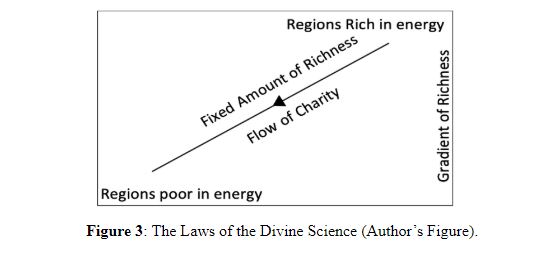
On the last note, Islamic schools are needed in order to teach natural and social sciences under the umbrella of the Divine Science with the Light of the Holy Quran and the Prophet (PBUH)’s sayings. This could be done by integrating Quranic verses and the Prophet (PBUH)’s sayings in the corresponding chapters of the textbooks and the teaching material.
For this goal, teachers should have not only the expertise in their field of science but also good knowledge of the explanation of the Quran and the Prophet (PBUH)’ sayings. As a result, scientific research will not be conducted for the benefits of some rich individuals but for the benefit of all humanity. Moreover, new scientific knowledge will be developed as a means to search for the Truth that brings us closer to Allah (SWT).
References
[1] Dr. Ragheb Elsergany (2011), Contributions of Muslims to the world in Islam story https://islamstory.com/index.php/en/artical/3407593.[2] Climate and Earth’s Energy Budget, NASA earth observatory.
[3] Dr. Cathy Riddle (2016); Why do batteries get used up and go dead? In https://idahoaskascientist.com/2016/11/14/why-do-batteries-get-used-up-and-go-dead/.
[4] Matt Williams, The Science of Heat Transfer: What Is Conduction?; Universe Today (2014).

